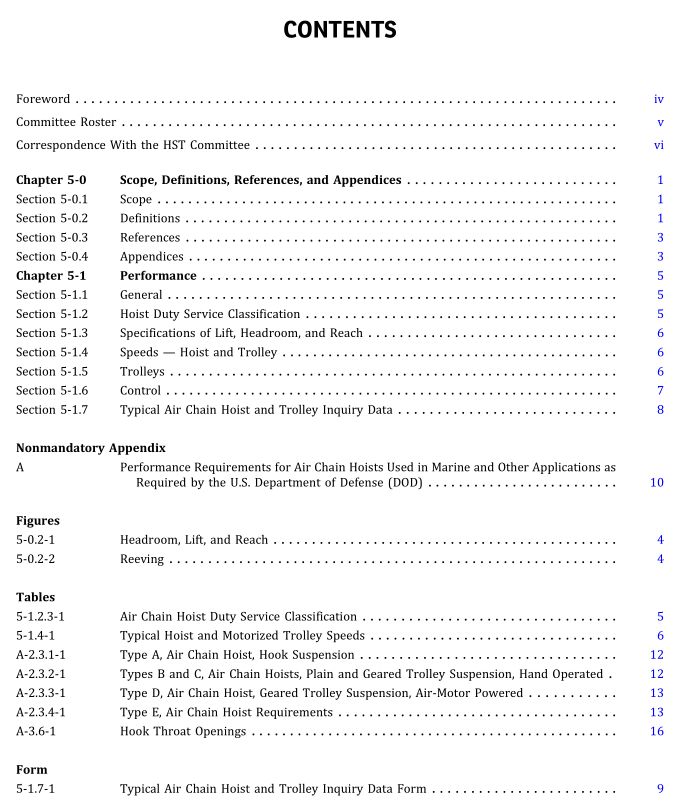ASME HST-5:2020 pdf download Performance Standard for Air Chain Hoists
SECTION 5-0.1: sCOPE
(a) This Standard establishes performance requirements for air-powered chain hoists for vertical lifting service in-volving material handling offreely suspended(unguided)loads usingload chain ofthe roller or welded linktypes with oneof the following types of suspension:
(1) lug
(2) hook or clevis(3) trolley
(b) This Standard is applicable to hoists manufactured after the date on which this Standard is issued. lt is not ap-plicable to
(1) damaged or malfunctioning hoists
(2] hoists that have been misused or abused
(3) hoists that have been altered without authorization of the manufacturer or a qualified person4) hoists used for lifting or supporting people,or
(5)hoists used for the purpose of drawing both the load and the hoist up or down the hoist’s own load chain(s)The requirements of this Standard shall be applied together with the requirements of ASMEB30.16.Please also refertoASME B30.16 for requirements pertaining to marking,.construction, and installation; inspection, testing, and mainte-nance; and operation.
SECTION 5-0.2:DEFINITIONS
abnormal operating conditions: environmental conditions that are unfavorable, harmful, or detrimental to the operationof a hoist, such as excessively high or low temperatures, exposure to weather, corrosive fumes, dust-laden or moisture-laden atmospheres, and hazardous locations.
armbient temperature: the temperature of the atmosphere surrounding the hoist.
beam: an overhead standard structural or specially fabricated shape on which the trolley operates.
brake: a device, other than a motor,used for retarding or stopping motion by means of friction or power.
brake, holding: a friction brake for a hoist that is automatically applied and prevents motion when the air supply isinterrupted.
brake, mechanical load: an automatic type of friction brake used for controlling loads in a lowering direction. Thisunidirectional device requires torque from the motor to lower a load but does not impose additional load on themotor when lifting a load. This may also be used as a holding brake if designed as such by the manufacturer.
braking, control: a method of controlling speed by removing energy from the moving body or by imparting energy in theopposite direction.
braking, dynamic: a method of controlling speed by using the motor as a compressor.chain, hand: the chain provided to control movement of a hand chain-operated trolley.chain,load: the load-bearing chain in the hoist.
chain,roller a series of alternately assembled rollerlinks and pin links in which pins articulate inside the bushingsandtherollers are free to turn on the bushings. Pins and bushings are press-fit in their respective link plates.
chain, welded link: a chain consisting of a series of interwoven links formed and welded.
NOTE: Load chain properties do not conform to those shown in ASME B30.9.
control: a device or group of devices that serves to govern in some predetermined manner the power delivered to theapparatus to which it is connected.
control, pendant: a valve system, connected to the hoist or trolley by hoses, that either directly controls flow of air to themotor or controls a pilot-operated valve system at the motor inlet.
control, pull:cords or chains suspended from the hoist, by means of which a valve system on the hoist can be operated.control, rod: a rigid rod suspended from the hoist,with which a valve system on the hoist can be operated.
hazardous (classified) locations: locations where fire or explosion hazards may exist. Locations are classified dependingon the properties of the flammable vapors,liquids, or gases, or combustible dusts or fibers that may be present, and thelikelihood that a flammable or combustible concentration or quantity is present. Refer to ANSI/NFPA 70.
headroom: headroom is measured with the load hook at its upper limit of travel and is the distance from the saddle of theload hook to the following locations (see Figure 5-0.2-1):
(a) saddle of the top hook on hook-suspended hoists
(b) centerline of the suspension holes on lug-suspended hoists(c) wheel treadline on trolley-suspended hoists
hoist: a machinery unit that is used for lifting or lowering a freely suspended (unguided) load.hoist speed: the rate of motion that the load hook obtains while lifting rated load.
hook suspended: suspension of the hoist from a trolley or rigid structure by means of a hook at top of hoist.
idler sprocket: a freely rotating device that changes the direction of the load chain.This device is sometimes called idlerwheel, idler sheave, pocket wheel, or chain wheel (see Figure 5-0.2-2).
lift: the maximum vertical distance through which the load hook can travel and is the total hook movement between itsupper limit of travel and its position when at the lower limit of travel (see Figure 5-0.2-1).
lifting devices, below-the-hook: devices that are not normally reeved onto the hoist chains such as hook-on-buckets,magnets, grabs, and other supplemental devices used for handling certain types of loads. The weight of thesedevices is to be considered part of the load to be lifted.
limit device: a device that limits equipment motion or takes control of particular functions without action of the operatorwhen a limiting condition is reached.
load, rated: the maximum load for which a hoist or trolley is designated by the manufacturer or qualified person.load, working: the external load applied to the hoist, including the weight of load-attaching equipment such as shacklesand slings.
load block: the assembly of hook or shackle, swivel, bearing, pins, sprocket, and frame suspended by the load chain.Thisshall include all appurtenances reeved in the load chain.
load chain container: a device used to collect the slack load chain.load hook: the hook used to connect the load to the hoist.
load sprocket: a hoist component thattransmits motion to the load chain.This component is sometimes called load wheel,load sheave, pocket wheel, chain wheel, or lift wheel (see Figure 5-0.2-2).
ASME HST-5:2020 pdf download
